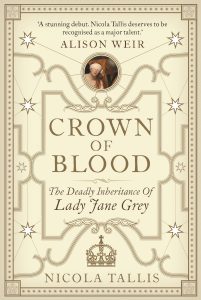On publication day of ‘Crown of Blood: The Deadly Inheritance of Lady Jane Grey’, Nicola Tallis was interviewed by Ben Jackson on BBC Radio Leicester.
The main points Nicola makes are:
It was integral to Nicola’s research to visit places associated with the subjects she writes about. Bradgate is an extraordinary place – landscape and scenery virtually unchanged since Jane’s day.
Lady Jane Grey is a lesser known figure because sources are scant and historians focus more on political events of Jane’s brief reign.
Nicola found more to Jane than previously expected.
Originally researched and wrote first draft of book about Lady Frances Brandon. Didn’t think there was much more to say about Jane. As examined sources more closely realized there was a really good story to tell about Jane.
In Europe, at the time, women’s learning was only just becoming fashionable. Highlights how extraordinary Jane must have been.
Jane’s death is barely mentioned in official reports. Although Jane was the youngest royal woman ever to be condemned for treason, ideas of maturity were much different in the Tudor period.
Jane’s intelligence, passion, enthusiasm for learning was one of the things that marked her out as special. The other was her fervency for the Protestant faith.
Aged 14/15 Jane struck up correspondence with Heinrich Bullinger, one of the most notable Protestant theologians on the continent. There is an element of hero worship in her letters to Bullinger.
At the end of her life Jane engages in a series of religious debates with Dr John Feckenham, Queen Mary’s chaplain, who tries to convert her to Catholicism. At this point it really becomes apparent Jane is determined to die as a martyr for the Protestant faith.
Element of Jane does show she was a rebellious teenager – taking too much time practicing music and too much interest in showy clothes.
It was unbelievable to hold a document that Jane signed, an amazing sense of engagement with your subject. Really hits home that this person was real. Incorporated several documents in her book that have not been used in previous biographies of Jane including one with her signature, that Jane would have handled at some point.
Many of the existing works about Jane concentrate on the political content surrounding her, rather than Jane the person. Over the centuries so many myths have attached themselves to her, that she has become somewhat lost behind everything and everyone else.
Really wanted to highlight to people that Jane was a real 17 year old girl who really existed on more than the pages of books and behind powerful men.
An example of a myth that has been wildly exaggerated:
Commonly believed that Jane was abused at the hands of her parents as a child. The evidence for that is based on one source. When you examine that source and the strengths and weaknesses, there are flaws in it.
On several occasions whilst writing the book, Nicola’s views changed and she rewrote the whole way through. Nicola thinks she ended up with hopefully as accurate an interpretation of Jane and her life as is possible.
Jane entered the Tower of London on 10th July 1553 as Queen and escorted to royal apartments. On the 19th she was deposed in favour of Mary and escorted to prison lodgings.
Initially Mary I made it clear that she wanted to spare Jane and eventually set her at liberty. Unfortunately, eventually Mary’s hand was forced by others.
Chiefly the January 1554 Wyatt Rebellion – Thomas Wyatt opposed to Mary marrying Philip of Spain, the plan was to replace Mary with her Protestant half-sister, Elizabeth. Although this had nothing to do with Jane, the fatal blow comes when Jane’s father, Henry Grey, becomes involved in the rebellion.
The rebellion fails and by that time Mary had no choice but to put Jane to death. This was a difficult choice for Mary, as she was very close to Jane’s mother, Frances (her godmother).
Jane had to endure the sight of her husband leaving the Tower to be executed on Tower Hill. Then about 10 minutes after he had left, she was confronted with the sight of his butchered body being returned to the Tower.
Jane has been preparing for her end for several days. She was escorted from her rooms to the site of the scaffold, which she almost certainly would have seen/heard being erected.
As she made her way to the scaffold she was deep in prayer, reading from the pages of her prayer book. Jane stood on the scaffold and made a composed speech, considering she was a 17 year old girl and she was about to lose her life in the most violent and appalling manner.
She was blindfolded and at that moment her calm temporarily deserted her because she realized that she could not find the block and cried out in panic, “Where is it, what shall I do?” It was only when a sympathetic onlooker guided her hands towards the block that Jane regained her composure. She stretched out her arms and the axe fell and severed her head with a single stroke.
Jane’s death did not draw much comment. It was only her supporters (those who knew her at home and on the continent), who began revering her as a Protestant martyr immediately after her death. This brave fearless woman who had died for her faith. But elsewhere Jane’s execution was basically unremarked upon.
The site now commemorated on Tower Green, was the place of only 2 executions. Jane was actually executed in front of the White Tower, close to the modern day entrance to the Crown jewels. Jane was the third royal women to be executed there in the space of 20 years.
Initially ‘Crown of Blood’ was written in a flashback sort of set up, then decided it would work much better chronologically. So Nicola had to unpick it all and stick it back together again. It was a labour of love.
Nicola finds it really interesting that there is no authenticated likeness of Jane. Refers to her in the appendix as ‘Queen without a face.’ We don’t really have that many contemporary descriptions of her either.
There are documents with her signature, so we know what her handwriting looked like. Haven’t quite got a face to put to the name and to his extraordinary young woman. It may well be that we will never have. There was at least one portrait of her in existence during her life.
To paint Jane as an angelic, perfect heroine is in some respects true but Nicola thinks in some ways it also does her a bit of a disservice. There was far more to her than that, she had spirit, she had determination and she had character. Jane was a pawn yes, but there was far more to her than that.






































